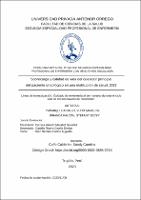Sobrecarga y calidad de vida del cuidador principal del paciente oncológico en una institución de salud, 2022

Date
2023Author(s)
Yupanqui Castillo, Yudit Marlene
Miranda Falcon, Stefany Becky
Metadata
Show full item recordAbstract
El presente trabajo de investigación es de tipo básico, se sustenta en la teoría de incertidumbre frente a la enfermedad por Merle Mishel. Tuvo por objetivo determinar entre el nivel de sobrecarga y la calidad de vida del cuidador principal del paciente oncológico en una Institución de Salud, 2022. La población estuvo constituida por 50 cuidadores principales de pacientes oncológicos a quienes se les aplicó la escala de sobrecarga del cuidador de Zarit y el cuestionario de Calidad de Vida “WHOQOL-BREF”. Los resultados obtenidos permitieron concluir que, el 34% de los cuidadores principales de pacientes oncológicos presentó sobrecarga de nivel leve y el 66% no percibió sobrecarga, no obstante, respecto a la calidad de vida el 82% de la población en estudio sostiene percibir calidad de vida regular y el 18% buena calidad de vida. Además, existió una correlación moderada negativa entre la sobrecarga y la calidad de vida [Rho de Spearman = -0,688; p= 0,000], indicando que, a mayor sobrecarga, menor calidad de vida del cuidado principal. Por tanto, se rechazó la hipótesis nula y aceptó la hipótesis alternativa. The present research work is of a basic type, the theory of uncertainty against the disease by Merle Mishel is supported. Its objective was to determine the relationship between the level of overload and the quality of life of the main caregiver of the cancer patient in a Health Institution, 2022. The population consisted of 50 main caregivers of cancer patients to whom the overload scale of the cancer patient was applied. Zarit caregiver and the “WHOQOL-BREF“ Quality of Life questionnaire. The results obtained allowed us to conclude that 34% of the main caregivers of cancer patients presented mild overload and 66% did not perceive overload, however, regarding the quality of life, 82% of the study population maintains that they perceive quality of life. regular life and 18% good quality of life. In addition, there was a moderate negative correlation between overload and quality of life [Spearman's Rho = -0.688; p= 0.000], indicating that the greater the overload, the lower the quality of life of primary care. Therefore, the null hypothesis was rejected and the alternative hypothesis was accepted.

